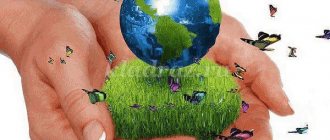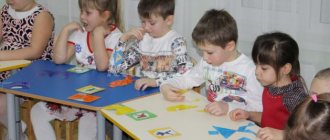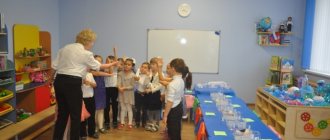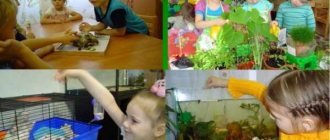Self-analysis of educational activities on environmental education in the senior group on the topic: “Our home is nature”
GCD Self-Analysis
in the older cognitive development group
on the topic: “Our home is nature!”
senior teacher
Danilova L.V.
Purpose of GCD
: Let children understand that nature is our common home,
Tasks
:
Cognitive development: continue to form an understanding of the role of nature in human life, expand and systematize children’s knowledge about nature, develop interest in the problem of nature conservation, introduce children to the norms and rules of behavior in nature.
Speech development: develop in children the desire to make a feasible contribution to the environmental education of the population, develop their horizons, thinking, and connected speech.
Social and communicative: Develop the ability to evaluate one’s own actions and the actions of peers. Foster a caring attitude towards nature.
Physical: formation of correct posture of children in class.
Artistic and aesthetic: teach children to read with the expression of a poem, cultivate a joyful, caring attitude towards awakening nature.
Vocabulary work: introduce into the children's active vocabulary: globe, planet, map, nature. Get used to answering with a complete answer.
Preliminary work: looking at a globe, memorizing a poem and physical education lesson, creating a presentation, developing signs, reading fiction, conversations, selecting audio recordings - forest melody.
Vocabulary work: introduce into the children's active vocabulary: globe, planet, map, nature. Get used to answering with a complete answer.
Materials and equipment: projector, globe, map of Russia, plasticine, modeling boards, stacks, illustrations, wood, candy wrappers, baskets.
.
Organizational activities, preparation for class
The lesson was carried out in accordance with the notes. The abstract was compiled independently, in accordance with the objectives of the main educational program of the preschool educational institution, corresponding to the older preschool age of children. To implement each task, techniques were selected, and material was presented in an interesting and entertaining form for the children to familiarize themselves with. .
For each moment of the lesson, visual aids were selected that stimulated and activated children’s mental activity. The manuals are of sufficient size and aesthetically designed. Their placement and use was rational, thoughtful in the learning space and in the lesson.
Music was used during the lesson to enhance emotional perception.
The organizational technique “Greeting” in poetic form” was aimed at developing communicative qualities and establishing friendly relationships both within the children’s team and with the teacher.
The lesson is dynamic, it includes techniques that provide for a quick change of types of children's activities. Conversation - sitting on chairs, moving around the group while looking for a way out of a problem situation, looking at a presentation with rules of conduct in the forest. Evaluating actions and rules, collecting garbage in the forest, also contributed to changing the types of children’s activities during the lesson, changing the children’s poses, taking into account Sanpin. A quick rotation of techniques and changes in poses during the lesson made it possible to avoid fatigue in children.
Didactic activities of the teacher:
All aspects of the lesson are logical and consistent, subordinated to one topic. Moments from the educational areas of Cognition were integrated into the lesson: she continued to form an idea of the role of nature in human life, expanded and systematized children’s knowledge about nature, developed an interest in the problem of nature conservation, and introduced children to the norms and rules of behavior in nature. Speech development: developed in children the desire to make a feasible contribution to the environmental education of the population, developed their horizons, thinking, and connected speech.
Social and communicative: developed the ability to evaluate one’s own actions and the actions of peers; fostered a caring attitude towards nature.
Physical: formed the correct posture of children during the lesson.
Artistic and aesthetic: she taught children to read with the expression of a poem, cultivated a joyful, caring attitude towards awakening nature.
The techniques in the lesson were of a playful nature, based on game-based learning situations,
The use of the presentation “Rules of Conduct in the Forest” helped to implement the main educational task in an interactive, interesting game form - to continue to form an understanding of the role of nature in human life, interest in the problem of nature conservation, and to introduce children to the norms and rules of behavior in nature. My role was to teach children to give detailed answers. This helped to achieve optimal results.
At every moment of the lesson, I tried to guide the children to find solutions to the problem, helped them gain new experience, activate independence and maintain a positive emotional mood.
The creation of search, problem situations intensified the mental and speech activity of children,
The specifics of working with children in the classroom were reflected in a person-centered approach. She encouraged timid children and praised them in order to consolidate their situation of success.
During the lesson, I tried to communicate with the children on the same level, tried to maintain the children’s interest in the lesson throughout the entire time.
The outcome of the lesson was organized in the form of a game problem situation “Let’s remove the garbage” so that during the course the quality of learning the material could be checked. Throughout the lesson, I sought complete, competent answers from the children to the questions posed. The children did not always give a complete answer.
Due to the fact that there were many choral responses, I plan to pay special attention to individual responses in the future. It is also necessary to achieve clear pronunciation of words. Work on sound pronunciation, expand active and passive vocabulary. But, despite these difficulties, I believe that all the program tasks I set during the lesson were solved. All Sanpin requirements for conducting a lesson were met: the time frame of the lesson is 25 minutes, in the middle of the lesson there is a physical minute, a change in types of activities and static poses during the lesson. The psychological requirements for the lesson were also met: at the beginning of the lesson, the children were interested, gathered, set up for the lesson, the problem was posed, the motivation for the lesson was determined, at the end of the lesson reflection was summed up, the result of the lesson - what we did in the lesson and why we did it, in the form resolving the problem situation “Let’s remove the garbage.”
Self-analysis article on the topic
Structural unit of the GBOU gymnasium
"Educational
g.o. Otradny Samara region "Kindergarten No. 13"
Introspection
work on the formation of environmental culture in preschool children
Educator: Gladysheva
Yulia Nikolaevna
year 2014
Modern preschool education reflects the general internal goals inherent in educational systems - to promote human development, cultural self-determination and productive inclusion in life.
In my work I use the main regulatory documents that determine the legal content of work with children and their parents:
International documents relating to children's rights.
- Declaration of the Rights of the Child.
- UN Convention on the Rights of the Child.
- World Declaration on the Survival, Protection and Development of Children.
Legislative acts.
- Family Code of the Russian Federation.
- Law “On Basic Guarantees of the Rights of the Child in the Russian Federation.”
- Education Act".
Regulatory documents in the field of preschool educational institutions:
- Charter of a preschool educational institution.
- An agreement between a preschool educational institution and the parents (persons replacing them) of the child.
In my professional activity, I have chosen the priority direction of environmental education of preschool children.
The existence of a number of environmental problems in our country and other countries of the world dictates the need for intensive educational work to develop environmental consciousness and a culture of environmental management among the population. It should start already in kindergarten - the first link in the system of continuous education.
Preschool childhood is one of the most important stages in the formation of personality and its value orientation in the world around it. During this period, a positive attitude towards nature, the objective world, towards oneself and other people is formed.
Environmental education undoubtedly makes a significant contribution to the formation of those qualities of children that are necessary for the socialization of preschoolers.
I consider the goal of this direction to be the creation of favorable conditions for the development of the personality of preschoolers through environmental education.
This goal is achieved through the following tasks:
- formation of cognitive, practical and creative skills of an environmental nature in preschool children;
- development of cognitive activity through experimentation;
- developing skills and abilities to observe natural objects and phenomena;
- development of positive moral qualities that encourage children to comply with norms of behavior in nature and society;
- education of ethical and aesthetic feelings, development of emotions by means of nature.
For more successful environmental education of children, I took into account the conditions (material and technical support of the educational process, consistency, greening, two-way relationship with parents). In our kindergarten there is a methodological room, which contains a rich library of methodological and scientific literature; the group has created a favorable subject-development environment for the educational process of children.
Having carried out monitoring on environmental education, I saw that young children do not have sufficiently developed positive and moral qualities that encourage them to comply with the norms of behavior in nature and society; Cognitive, practical and creative skills of an environmental nature have not been developed.
I have identified the following tasks:
1. Expand children’s understanding of plants and animals.
2. Give an idea that plants need soil, water and air to grow.
3. To introduce the characteristic features of successive seasons and the changes that occur in connection with this in the life and activities of adults and children.
4. Give an idea of the properties of water (flows, overflows, heats up, cools), sand (dry - crumbles, wet - molds), snow (cold, white, melts from heat).
5. Develop the ability to understand the simplest relationships in nature.
6. Introduce the rules of behavior in nature.
Taking into account the age characteristics of young children, I built my work on the principle “what I see is what I know.” The main condition of my work is to create a favorable creative atmosphere. To do this, I create a safe developmental environment in the group that promotes the harmonious development of the child, creates a sense of self-confidence in him, and also gives him the opportunity to independently manage its components. Visual aids became my assistants here. With the help of their parents, we made fake trees for the seasons, flowers, birds, and bugs that were familiar and understandable to children of that age. And together with the children we take walks to trees and flowers. We greet them, find out how they are doing, determine their mood. With the help of beautiful instrumental music combined with the sounds of nature, we learn to feel beauty and kindness. A weather calendar was made, where children can mark changes themselves using pictures, objects, and chips. Pictures of different sizes with plants and animals were selected according to seasons and habitat. An album “Seasons” with moving pictures was made. For the didactic game “Doll Masha gets dressed for a walk,” a multimedia presentation was developed, where children were given the opportunity to choose clothes according to the weather.
The youngest age is the most favorable for sensory education, for the accumulation of ideas about the world around us. Therefore, in directly organized activities, I widely use visual aids, objects that a child can pick up. Thus, when familiarizing themselves with vegetables and fruits, children examined them tactilely, using smell, tasted them, examined them, noted their color, shape, and taste. In directly organized activities, I widely use visual aids, objects that a child can pick up. I build GCD with children in the form of a game. The main link of the game is an imaginary situation and game motivation, which I support throughout the entire NOD: “Journey to Lesovichok”, “Visiting Grandma Matryona”, “Enchanted Letter”, etc. On them, children listen to audio recordings, help animals and heroes of works of art, make crafts, etc.
To stimulate the child’s mental activity and expand his range of interests, entertaining games were played: “Build a road for a bunny from stones”, “Snowflake visiting the children”, “Great Helpers”, “Bathing the doll Dasha”. Such types of activities create the prerequisites for revealing the child’s emotional potential and nurturing basic environmental awareness.
In the middle of the school year, I saw that children were having difficulty mastering the material they had received on environmental education, and I decided to create an experimental center in a group in which children working together with me had the opportunity to conduct simple experiments. For this purpose, the parent committee of the group was involved. With the help of our parents, we organized an experimental corner (river sand, stones, shells, clay were brought, material for experimental activities was purchased). After the experimental corner was organized, the work began to be more intense and interesting. To form an understanding of the properties of water and sand, we conducted experiments with water with children: we looked at clean and dirty water, cold and hot, experiments with sand: dry - crumbles, wet - molds. In the winter season, they conducted experiments with snow and ice, determining whether ice or snow would melt faster, etc. Experiences and observations are repeated, become more complex, and are transferred from the group to the natural environment and vice versa. The final comprehensive classes conducted provide an opportunity to summarize the material and leave a bright mark on the child’s soul.
In the experimental corner, children not only conduct experiments, but also carry out independent activities. In the center of water and sand, kids play: pour sand from palm to palm, from a scoop into a mold, bury various objects in it and dig them out, build slides, paths, etc.
After the group was provided with an experimental corner, the work began to be more intense and interesting. Children have become more active in games, conversations, and during targeted walks.
The natural corner was supplemented with cards with rules of conduct in nature, and an electronic teaching aid “Take care of nature!” was produced.
With the help of parents, the educational environment was enriched with didactic games: “Tops and Roots”, “Wonderful Bag”, “Whose Cub”.
At the end of the school year, after conducting monitoring, I noticed that not all of the assigned tasks had been solved. Thus, a need arose for further testing of the system of work to increase the level of environmental education of children.
Conclusion: The work carried out on environmental education allowed us to come to the following results:
- children became more interested in the surrounding nature and the world
plants and animals;
- children have formed initial ideas about themselves
(man is a part of nature and obeys its laws), about the intrinsic value of nature, a positive attitude towards it;
- children have developed the first skills of environmentally literate and
safe behavior in nature, the desire to treat it with care.
Based on this, tasks were set for the following age period:
- mastering the immediate environment and moving beyond it in an age-appropriate manner;
- expansion and systematization of elementary geographical, natural science and environmental ideas of preschoolers;
— developing skills in conducting basic experiments and the ability to draw conclusions based on the results obtained;
- developing skills of caring attitude towards objects of living and inanimate nature, to the place in which you live;
— development of the ability to perceive the aesthetic value of nature and express the impressions received in creativity;
-involve the parent community in active cooperation.
Children of older preschool age have a higher level of knowledge, assessments and behavioral attitudes. They have a fairly large vocabulary, which gives them the opportunity to convey in stories objective connections and their feelings, their sensory experience associated with the properties of natural phenomena. At this age, environmental ideas are concretized and supplemented with new material.
When building a system of work on environmental education for older preschoolers, I identified the following main directions:
- the cognitive direction of work includes a cycle of educational activities that contribute to a deeper expansion of pupils’ environmental knowledge;
- The educational and entertaining direction of work aims to introduce children to the components of living and non-living nature, the influence of human activity on these components in a playful and entertaining way;
- the practical direction of work contributes to instilling a caring attitude in children towards their native nature through labor education and close cooperation with parents;
- The research direction of the work is carried out through experimental activities of children, excursions and observations of nature.
I am implementing ways for the environmental education of children of senior preschool age.
- creation of conditions (greening, software and methodological support);
- increasing your own environmental awareness;
- study and application of modern methods and technologies in teaching and raising children;
- environmental education of parents.
In her work, she paid great attention to search and experimental activities, so all classes with children are structured using not only direct teaching methods (explanatory-illustrative, reproductive), but also problem-based teaching methods (problematic presentation, partial search, research). The classes also included moments of experimentation, both demonstration and independent.
She continued to work in the experimental corner, the experimental work aroused children’s interest in exploring nature, develops mental operations (analysis, synthesis, classification, generalization, etc.), stimulates the child’s cognitive activity and curiosity. Over the course of the year, parents replenished the experimental center with manuals and natural, waste materials, cones, test tubes, a microscope, magnifying glasses, and compasses. The final stage of the experiment is very important - analyzing the results and drawing conclusions. Preschool children think in images. Therefore, they often cannot express what they understand. In this case, I do not conduct a frontal survey, but give the children the opportunity to share the joy of discovery in a relaxed manner. The experiment allows children to be introduced to safety rules when conducting an experiment.
When selecting material for direct educational activities, I focus on the fact that our children are not only inquisitive, but also very active, their attention is not stable enough, and only vivid emotional events and images are recorded in their memory. To ensure that learning new knowledge brings joy to children, I conduct classes using games, music, and television. These are a variety of games, films about animals, natural phenomena, presentations. I have selected various materials on digital media about living and non-living nature, and compiled various presentations “Cosmos”, “Inhabitants of the Forest”, “Underwater World”, “House Plants”, “Queen of Water”. The classes on getting to know the surrounding world included a variety of ecological electronic didactic games: “Who lives where?”, “What grows...?”, “What, who is the odd one out?”, “Ecological chains,” “Who is friends with whom?” , “Forest House”, I widely use games with natural materials, word games. All this helps children cope with learning difficulties, concentrate better and easier, maintain attention longer, distribute it correctly, and also develop auditory and visual memory, form children’s vocabulary, communication skills, and most importantly, make the learning process attractive and interesting for them. helps the child learn the material more easily.
During each lesson, there was time for relieving mental and physical stress of 2-4 minutes. I selected the content of such physical education minutes based on the topic of the lesson and focusing on the condition of the children. This can be a dynamic exercise with speech accompaniment, finger gymnastics, an eye exercise, when working in speech therapy groups I use pronouncing phrases with movements, exercises for the tongue.
In joint and independent activities, she used various forms of organizing children. She offered children printed board games “Zoological Lotto”, “Botanical Lotto”, “Seasons”, “Berries and Fruits”, “Plants”, “Pick Up Leaves”, paired pictures, and also used dramatization games in her work. Every morning I conducted “Mental exercises” with the children, in which I used a variety of verbal environmental games, riddles, tasks, and ball games.
In the group, with the help of parents, in accordance with age characteristics, we organized a “Nature Corner”, which contains a nature calendar, where the children and I noted the weather conditions. Also, with the help of parents, an “Ecological Library”, herbariums, a corner for independent experimentation, board and didactic games “Who eats what?”, “Who lives where?”, “The fourth odd one”, “Who needs water”, etc. .d., various illustrations and reproductions about nature and the seasons, layouts were selected. The child can play in this corner at any time, conduct experiments and experiments. Also in the “Nature Corner” there is a collection of didactic clocks; they help children consolidate their knowledge of the seasons, months, and days. The “Nature Corner” hosts a constantly updated exhibition of children’s works about natural phenomena, animals, birds, sea inhabitants, etc. Every day, joint activities are carried out in a corner of nature (duty), which introduces children to work responsibilities, develops diligence, a sense of responsibility, independence, and the ability to be sensitive to work.
During walks, I introduced children to changes in nature according to the seasons (length of day, weather, changes in the life of plants and animals, human labor). During our walks, the children and I organized games with natural materials (sand, water, snow, leaves, fruits). Children really like to play games with toys driven by the wind: “Sultans”, “Multi-colored ribbons”. Through such games, children can determine the strength and direction of the wind, its contrast.
Environmental projects have become an effective form for developing environmental ideas in children: “This amazing ice”, “Vegetable garden on the window”, “Water, water”. The content of the projects included experimentation and experiments. The experiments were built on the basis of existing ideas that the children received in the process of observation and work. During the work, I paid attention to using all the child’s senses, and not just hearing and vision. To do this, children were given the opportunity to touch, smell the objects around them and even taste them, if it was safe to do so. It was during the walk that during the experiments the children became acquainted with the properties of sand, earth, snow, ice, and water.
When consolidating environmental knowledge in children, I attached great importance to the leading form of activity of preschoolers - the game (role-playing, active, independent games with ecological and natural history content). For the convenience of using environmental games in the classroom, I made card files of environmental games by age. Transformational games aimed at developing a child’s sympathy for animals, plants, and inanimate objects, for example, “Prepare medicine,” “Build a house for an animal,” helped to develop positive emotions towards nature.
It has become a good tradition for us to take care of wintering birds. Even from the younger group, various activities and conversations with children about birds were held. Together with the children, on walks in the winter, we fed the birds, observed which birds flew to the site, how they pecked food, and how they moved around our site. This aroused great interest among the children and a desire to take care of the wintering birds. Seeing this interest of children in birds, I decided, with the help of my parents, to organize the “Feed the Birds in Winter” campaign with the goal of cultivating a sensitive attitude towards birds and a desire to help them in winter. Where the children, with the help of their parents, made feeders and hung them throughout the city so that residents could feed the birds, I also held the “Let’s decorate the earth with flowers” campaign throughout the year, and I carried out the resource-saving campaign “Take care of our water”, “Beautiful Christmas tree”. My parents liked to take part in such events and suggested that I jointly organize an environmental newspaper “Touch Nature with Your Heart.”
I organized the “Vegetable Garden on the Window” project, where the main participants were parents, they brought seeds, soil, and dads made boxes for seedlings. Children enjoy growing seedlings for flower beds. This form of work allows us to identify and develop new abilities in the child, develop the humanistic and aesthetic traits of the child’s personality, the ability to empathize, treat things with care, not only because it is someone else’s work, but also because these are materials taken from nature .
To work with parents, I design folders on environmental topics, for example: “Ecological laws”, “Healing trees”, “Indoor plants and home ecology”, etc. I hold parent meetings (topics: “Teach children to feel nature”, “Use fiction in the environmental education of preschool children", "Child and Nature". Together with parents, we publish an environmental newspaper "Touch Nature with Your Heart".
I involve parents in joint creativity with their children in making crafts from natural, waste materials, with whom they participated in the “Autumn Kaleidoscope” and “Green Planet” competitions. Working with parents helps achieve the desired results in the environmental education of the child. Only through joint efforts can we develop the personal qualities of a preschooler.
Thus, I believe that environmental education has a positive effect on the development of a child’s personality. In addition to educational knowledge and skills, it develops and educates the aesthetic and ethical qualities of a preschooler’s personality, fosters a sense of responsibility for the native nature, region, a sense of citizenship and patriotism, and educates a humane personality, morally and physically healthy.
Self-analysis of the open lesson “Save water! “article on the world around us (preparatory group)
Self-analysis of ecology classes in the middle group.
Number of children: 7 children aged 4 years attended the lesson.
Lesson topic: “Save water! »
The lesson was conducted in accordance with the requirements of San Pin. During the lesson, the lighting in the group room was sufficient, all lighting sources were kept in good condition. The group is equipped with children's furniture (chairs and tables) that correspond to the age of the children.
TV and video viewing was carried out in accordance with the standards of San Pin.
I presented a lesson in which the following educational areas were integrated: speech development, cognition, artistic and aesthetic development.
Motive of the lesson: Formation of the idea that water is very important for all living beings: water is the source of life.
Purpose of the lesson: development of cognitive activity in the process of experimentation; teaching to respect water, to form a cognitive process towards nature.
Tools used in the lesson: the following methods were used in the lesson: gaming, visual, verbal, practical, which reflected the same topic and were closely interrelated.
The lesson process consisted of 3 interconnected parts: preparatory, main and final.
Part 1 – preparatory – was aimed at motivating children. At this stage, children's knowledge about water and its role in the life of living organisms was generalized. The verbal method was used: story, asking riddles, visual method - presentation. A surprise moment was used (Guest – Droplet)
Part 2 - the main one was based on experimental activities: experiments were carried out with water,
Verbal: during the lesson, leading questions were asked (conversation with children), pedagogical assessment: teaching during the lesson and educating at the end of the lesson;
Practical: performing physical education exercises
The set of methods used made it possible to increase the effectiveness - children’s mastery of the chosen topic. I tried to reveal these methods using a variety of techniques. I tried to ensure that the activities were aimed at the effectiveness of the planned methods and techniques.
Part 3 was the final part; it summed up the learning activities with the help of children’s answers to the questions asked. The children were offered a productive activity - coloring the fish.
Results of the lesson: I believe that the equipment and material used in the lesson allowed me to maintain the attention and cognitive interest of the children throughout the lesson.
Throughout the lesson, I tried to create a situation of success for each child. To prevent overwork of children and maintain constant interest, I ensured a change in types of activities. I built the entire process on the basis of an activity approach, creating conditions to make the child motivated to acquire knowledge and demonstrate existing skills, promoting the development of curiosity and activity
From the very beginning of the activity, the children were ready to solve a problem situation, as they were confident in the guiding help on my part. Our communication was emotional; we were partners throughout the entire lesson.
The structure of the event was built in such a way that all its parts were interconnected and corresponded to the theme. A variety of activities ensured the stability of the educational atmosphere. To achieve the result, I relied on the individual, age and psychological characteristics of a given age. Training, development, and educational tasks were solved in unity. The main stages clearly transitioned from one to another.
I believe that I managed to achieve the goal of the lesson through the implementation of all the assigned tasks. In conclusion, I would like to thank you for your attention and hope that your opinion about the event will help me further improve my professional skills.






